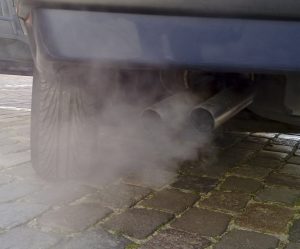Source: Wikimedia Commons
Saying California and the Federal government don’t see eye to eye right now is a bit of an understatement.
On the one hand, California has pledged to put 5 million electric vehicles on the road by 2030, met its greenhouse gas reduction (GHG) goals four years early and has re-focused its climate policies to clean up our most polluted communities.
On the other hand, the Trump Administration’s Environmental Protection Agency (EPA) was previously led by a climate change denier, is currently being led by a former coal lobbyist, and has rolled back or is in the process of rolling back 45 (and counting) environmental regulations ranging from water quality, toxic materials and lead paint.
However, the biggest battle between California and the Federal government is over clean cars. While details are limited as of this post, the EPA is posed to freeze fuel efficiency requirements at 2020 levels, as well as attack California’s authority to regulate tailpipe GHG emissions and require car manufactures to sell a minimum number of electric vehicles. This salvo undoes the hard-won agreement between California and the Federal government, undermines American competitiveness and puts clean air and your health in the crosshairs.
Clean cars and the Federal-California Relationship: #itscomplicated
California and the Federal government have a complex relationship when it comes to automotive emissions.
Generally, the Federal Clean Air Act prevents states from setting their own emissions standards for vehicles – California being the lone exception. This is because California’s regulation of car emissions predates the Federal government’s, and our persistent air quality problems require more aggressive standards. To receive a Clean Air Act waiver, California’s standards must be at least as stringent as Federal government’s regulations, are needed to meet compelling and extraordinary needs (namely, California’s air pollution) and cannot be arbitrary. While other states can’t set their own standards, they can choose to either follow Federal standards or California’s. Currently, 12 other states – roughly 1/3 of the automotive market, follows California’s standards.
It’s important to note the EPA has never revoked a waiver since the Clean Air Act’s enactment over 40 years ago. Additionally, the Clean Air Act does not provide a way to revoke a waiver. However, California has been denied a waiver in the past, and that experience shows the stakes are very high.
This isn’t California’s first rodeo…
Historically, California’s tougher auto emissions requirements served as a model for Federal regulation. When the Federal government created its first emissions standards in 1968, the EPA pegged its regulations to California’s existing standards. However, the current clean cars conflict between California and the Federal government dates to 2002. That year, then-Assembly Member Fran Pavley authored AB 1493 (of which CCA was a co-sponsor), which required the California Air Resources Board (CARB) to create regulations requiring the “maximum feasible and cost-effective reduction” of GHGs. Though the EPA denied the waiver request in 2007 under the Bush Administration, a compromise was eventually reached under the Obama Administration in 2009. In order to achieve the desired greenhouse gas emissions reductions, the final regulations required cars to essentially meet California standards. The Trump Administration’s proposal would halt the progress that’s been made so far, as well as eliminate California’s ability to require clean cars.
…but the stakes are much, much higher.
Freezing the standards is a massive threat to the air and atmosphere. According to Energy Innovation, freezing the standards and revoking California’s emissions authority could result in an 11% increase (nearly 150 million tons) in greenhouse gas emissions through 2035. Additionally, fuel consumption will be 20% higher in 2035 than it would be if current policy and California’s waiver were to stay in place. Most alarming, though, are the potential health impacts. Two professors at Harvard recently found that rolling back standards could result in thousands of more deaths and over 140,000 additional respiratory ailments over the next decade.
However, the impacts of rolling back the clean car standards are not just limited to the health and the environment. According to Energy Innovation’s research, the cost from increased fuel consumption will be between $274 to $457 billion dollars by 2050. And this doesn’t even begin to factor the public health costs due to increased ailments from auto emissions. Nor does it factor in the cost of discouraging innovation and competition as the dirtiest manufacturers will have an advantage over cleaner, advanced car companies and technologies.
So, what’s next?
Once the draft regulation is published, the EPA will have a 60-day comment period. After that period, the EPA may modify and ultimately enact the proposed regulation as it sees fit. Should the EPA freeze clean car standards and/or revoke California’s air pollution authority, it’s almost certain that California and the other states that follow our standards will sue the Federal government. Ultimately, this issue will likely be decided by the courts, a future Administration or a new Congress.
However, there are steps you can take today to support clean cars:
- Call your Federal Representatives and Senators and let the know you support the clean car standards
- Let the EPA, Department of Transportation and President Trump know you oppose rolling back the clean car standards by tweeting @EPA, @USDOT and @realdonaldtrump
- Write a comment during the 60-day public comment period and state your opposition to the proposed rollback.
Rolling back the clean car standards is a major threat that not only undermines public health and the economy, but also the ability for the largest state in the nation to address its air quality issues. California has prevailed in challenges like this before. However, it’s going to take all of us to overcome this threat.
[share title=”Share This Post”]








